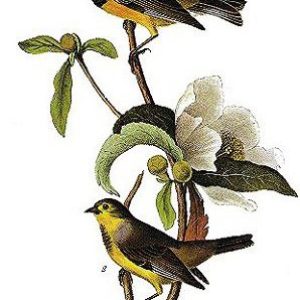calsfoundation@cals.org
Bachman's Warbler
aka: Vermivora bachmanii
Bachman’s warbler (Vermivora bachmanii) was a small, yellow-and-black bird of the American wood-warbler family (Parulidae) that formerly nested in the southeastern United States, including Arkansas. In winter, Bachman’s warblers migrated south to spend the winter on the island of Cuba. Preferring swampy bottomland habitat, the species suffered severe population decline in the early twentieth century when that habitat began disappearing and was believed by most ornithologists since the 1960s to be extinct. It was officially declared so by the U.S. Fish and Wildlife Service in 2021.
Bachman’s warbler was discovered in 1832 near Charleston, South Carolina, by the Reverend John Bachman, a skilled amateur naturalist. Bachman (pronounced BACKman) was a close friend to John James Audubon, the famed naturalist and artist. Audubon painted a pair of the birds based on skins (prepared specimens) and named the species for Bachman. Audubon himself never saw a living Bachman’s warbler.
The known breeding range of Bachman’s warbler extended from southeastern Missouri and northeastern Arkansas to South Carolina. Various theories have been offered to account for the population decline and eventual extinction of the species. Most biologists think that loss of bottomland forest and associated land clearing for agriculture were the main reasons. Although scientific research on the bird is limited, Bachman’s warbler seems to have preferred brushy terrain that was slightly elevated from the surrounding swampy areas, which was the easiest ground to clear for cropland. Another possible factor in the bird’s decline was a series of hurricanes that hit Cuba (its only wintering area) in the 1930s, possibly killing a significant portion of the entire population.
Bachman’s warbler was first seen in Arkansas in May 1896, in the St. Francis River bottomland of Greene County. Otto Widmann, a German-born naturalist who lived in Missouri, found two males singing but did not see a female or find a nest. In 1897, Widmann discovered a nest of the species across the river in Missouri, the first known to science.
Interestingly, Arkansas may have missed the opportunity to be the site of the Bachman’s warbler nest discovery for an unusual reason: foul odor. After Widmann saw the two males in Greene County in 1896, he intended to continue searching for a nest, but “circumstances, among them, two very dead hogs” caused him to give up for the season. He returned to the area the next year and found the nest in Missouri.
As late as 1911, Bachman’s warbler was reported in A. H. Howell’s Birds of Arkansas as a “moderately common breeder in the Sunken Lands of northeastern Arkansas.” A male Bachman’s warbler was collected (shot while singing in a tree) at Winslow (Washington County) in 1914; the specimen is now in the Denver Museum of Nature and Science in Colorado.
The last confirmed sighting at any location occurred near Charleston, South Carolina, in 1961. Ornithologists conducted a systematic search for Bachman’s warbler in the period from 1975 to 1979 in South Carolina, Missouri, and Arkansas, without success. A few other sightings have been reported in the years since, but none has been photographed or otherwise unquestionably documented.
In September 2021, the U.S. Fish and Wildlife Service announced that the Bachman’s warbler, as well as the ivory-billed woodpecker and twenty-one other animals, had gone extinct.
For additional information:
“Bachman’s Warbler.” National Audubon Society. http://www.audubon.org/birds-of-america/bachmans-warbler (accessed October 4, 2021).
Baerg, W. J. Birds of Arkansas. Bulletin No. 258. Fayetteville: Agricultural Experiment Station, University of Arkansas College of Agriculture, 1951.
Dunn, Jon, and Kimball Garrett. Warblers. Boston: Houghton Mifflin, 1997.
Howell, A. H. Birds of Arkansas. Biological Survey Bulletin No. 38. Washington DC: U.S. Department of Agriculture, 1911.
James, Douglas A., and Joseph C. Neal. Arkansas Birds. Fayetteville: University of Arkansas Press, 1986.
Mel White
Little Rock, Arkansas
 Bachman's Warbler
Bachman's Warbler 




Comments
No comments on this entry yet.